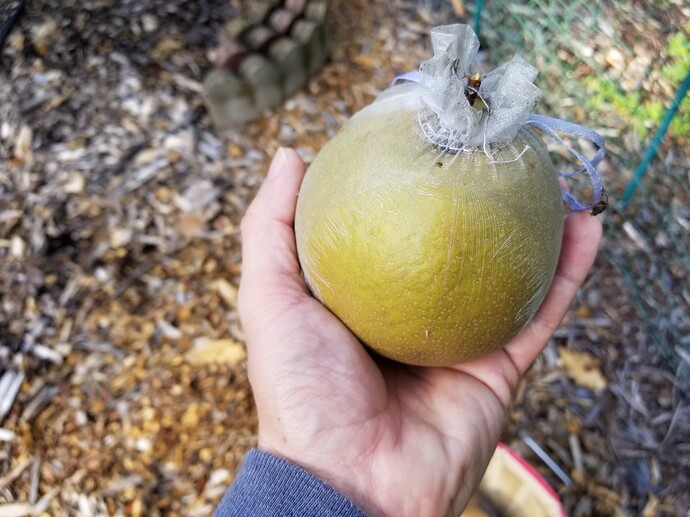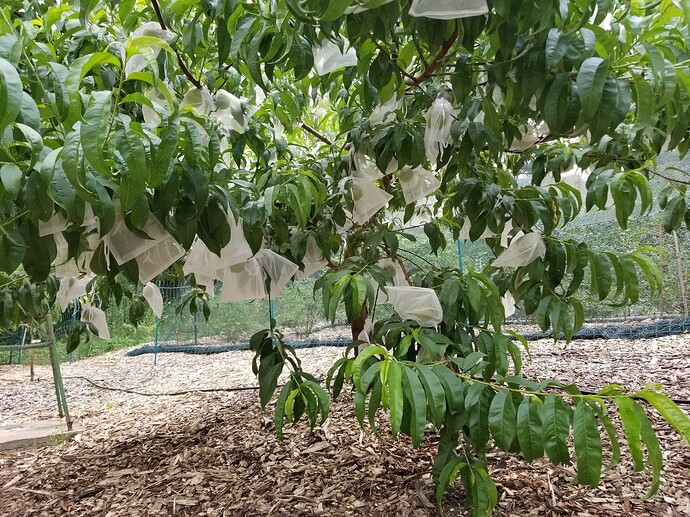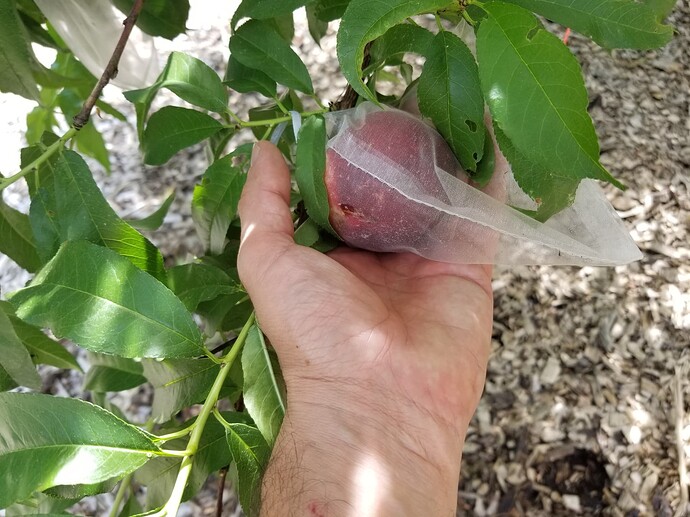The last place I lived all the apples had a hole in them every year & now about ten miles away I have the same problem. I don’t know when they show up but I sure would like to eliminate these rotten little pests. What’s the best way to handle these little suckers?
I am really not sure but I would guess surround maybe. (I wouldn’t listen to me unless someone else agree, I am not an apple expert)
The Permaculture Orchard (Stephan Sobkowiak) has videos of the traps that he makes on Youtube. He doesnt spray though…
Basically, you have three options bag the fruit, spray Surround ( a kaolin clay), or spray an insecticide. I think some people also use traps but I am not sure of there effectiveness.
Which works best depends on your situation. If you explained situation in detail we could offer more advice. Are your apples trees large or small? Are you willing to spray an insecticide? Or are you willing to spray Surround even if it requires more frequent sprays than an insecticide?
Presence of adults can be detected by trapping.
An insecticide application is warranted if there have been a total of five flies caught per red sphere trap baited with apple volatiles, or one fly caught in an unbaited red or yellow trap. This action threshold should be used after each insecticide application as well as to reevaluate if another insecticide application is needed.
- Deutsch, Annie, and Christelle Guédot. Apple Maggot. Madison, University of Wisconsin-Extension, 2018. A4159. 29 May 2022 <https://cdn.shopify.com/s/files/1/0145/8808/4272/files/A4159.pdf>.
I would prefer organic control but I’m guessing I would have to spray after it rains which happens a lot here. So I’m not very interested in the clay but I don’t have a lot of fruit yet (less than 100) & the fruit is low so it’s a possibility. Although it seems like I would need a special sprayer that wouldn’t clog up?
I’m not totally against an insecticide if it’s not real toxic but even the Bonide fruit tree spray I heard was pretty safe sounded like nasty stuff when I read the label so I’m concerned it’s not safe & wouldn’t want the overspray all over the ground & grass my dog walks through every day. I just heard about Spinosad and that sounded great but then heard the sun breaks it down in a day. Does anyone know what they spray on commercial orchards?
I didn’t look into traps because I heard they can actually attract more moths and make things worse but I will look into it. Bagging always sounded like a major pain but I will look into that as well.
Before you do anything I would figure out if you have apple maggot fly or codling moth. The latter leaves a hole. I don’t have apple maggot so don’t know much about it. But I spray Surround and spinosad which together should give good control for either maggot fly or codling moth.
It sounds like I have codling moth since there are holes. I guess I will have to learn about the life cycle and exactly when to spray for them.
You’re in a similar zone as I, so maybe my experience with codling moth will help. First of all, I let the local country extension people tell me when to spray. Every week they post a pest guide: May 24th Pest Alert Message | Missoula Weed District. When they say spray I spray.
There will be three or four generations of CM every summer and you have to spray for each. You can control them pretty well with just spinosad if your timing is perfect and if the weather cooperates. I spray a synthetic for the first two generations, but switch to spinosad for the third and fourth. I’ve been using Spectracide’s Once and Done, but this year I’m switching to Malathion for the first two sprays. I don’t want the pests to develop a resistance to any one spray. And by switching from the synthetics that early I’m giving them more time to break down - well more than the pre-harvest interval specified on the container.
The tricky thing about timing your spray is that you want it on the fruit when the eggs that the active adults laid begin to hatch - not when you first start catching codling moths in your trap. And that depends a lot on the temperature.
The only other sprays I use are dormant oil and occasionally some sulfur to knock back powdery mildew.
I hope this helps.
There are two spray schedules on the site- Alan’s synthetic schedule and Scott’s low impact semi-organic schedule. I have attached links to both. I think both are worth reading through.
Myself I spray a synthetic insecticide once or twice and then bag. Bagging is easier than you think especially when comparing to spraying. With bagging you bag once and you’re done. With spraying the process has to be repeated multiple times. When I bag I wear a t-shirt and shorts. When spraying I wear long pants, long-sleeved shirt, a hat, rubber gloves and eye protection. It can get uncomfortably hot when spraying in hot humid weather. I can also bag when it’s windy and I can’t spray.
So bagging has it’s advantages. It works best on small trees or at least short ones since ladder work is minimized. I bag about a 100 a year right now. I think some people on the site bag in the 400-500 range but numbers above this are probably not practical for most people. Apples are bagged when dime size or bigger but insects sometimes attack the fruit before it reaches this size which is why I spray before bagging. So you might give bagging a try.
Awesome! Wish my area had the same.
You can also stop the Apple Maggot fly by covering your whole tree with a mesh cover that is fine enough to keep the flies away from the young apples. You can tell the difference between apple maggots and codling moth larvae by where they are feeding in the apple. Codling moths focus on the core of the apple and apple maggots tunnel through the flesh of the apple. You can also tell whether you have maggots because they will continue to eat the apple flesh until it shrivels and drops to the ground. Codling moth larvae get to the tree as an egg laid on the outside of the apple. They have to eat their way in making them susceptible to sprays on the outside of the apple. They eat for a while, then the larvae leave the apple leaving a hole. The apple stays on the tree. Apple Maggot flies are approximately 5 mm long and 2 mm wide. Codling moth adults are about 2 mm wide and about 5-6mm long. Because the fly inserts its eggs directly into the fruit with an ovipositor, once the egg is inside the fruit, insecticides are not terribly effective. The maggot does not leave the apple while it is on the tree. It leaves no holes, either on the way in or the way out. Sprays for codling moth show some effectiveness in killing adult flies in the scientific literature, but are not completely effective. Once you have codling moth larvae or apple maggots, the apple is really damaged. The most effective interventions for both insects stop the parent bug from laying the eggs in or on the apple. Once you have the little caterpillars or maggots, you have lost the battle for that apple.
I used to bag 3000-5000 individual fruits per season for about 15 years. Technically, I hired workers to help me. I have an orchard with semi-dwarf trees that each produce about 800 apples a year. I would bag both pears and apples. I found bags to be about 90-95% effective at keeping out codling moths. My immediate area does not seem to have apple maggots, although they are known to exist in the county where I currently have my orchards. I prefer bagging to spraying like you, because it can be done in a wide variety of weather conditions, and it is chemically safe to the people working the orchards. I found it to be more effective than spraying because you only have to install the bags once a season. But it is quite expensive and time consuming.
The traps work only for adult male moths. You can use really strong bait in an attempt to confuse ALL the adult males, but this works only for areas large enough that already bred females can’t migrate in. In smaller areas, trapping males is futile except as an indication when breeding is occurring.
I’ve posted a little about that!
I just read your detailed website on the life cycle of codling moths. It is a detailed, extremely clearly written series of pages on the many complexities of the the life cycle of codling moths. For me, a long time serious backyard grower of apples and pears, it was very illuminating. Many scientific scholarly works on codling moth and their controls do not consider the actual situation of the backyard grower, but are focused on the very large commercial grower. Many articles targeted for the backyard grower, do not address the known science of the bugs themselves sufficiently accurately enough. One question I do have on your piece is many of the chemical substances you describe for control seem to be no longer legal to use, or require licenses for to apply them. For example, I do not see Imidan, organophosphates, many of the neonicotinoids, being available for purchase to the backyard grower. Are the products you list substances that you would recommend be used by a backyard grower? For example if I read the label for Imidan, I would not recommend a backyard grower use this substance: Imidan Label precautions
Thanks for reading! The article sort of peters out on the topic of chemical control. Its content is taken from scholarly sources that are quite old, and I’m not up-to-date on what is available or even allowed to backyard orchardists.
For example, this comprehensive reference:
- Cooley, Daniel R., et al., ed. 2015-2016 New England Tree Fruit Management Guide. UMass Extension.
… used to be online, but isn’t anymore — presumably because it has been replaced by newer editions that UMass’ publisher is eager to sell dead-tree copies of. … so it goes.
Regarding the substances you mention:
Imidan
The active ingredient is an organophosphate (OP) called Phosmet. Yes, I agree: The label precautions are a bit strange.
East of the Rockies: Do not enter or allow entry into treated areas during the restricted entry interval (REI) of 4 days.
West of the Rockies: Do not enter or allow entry into treated areas during the restricted entry interval (REI) of 7 days.
… but wait! Growing Fruit has a thread on the topic from a few years ago:
There appear to be several online catalogs listing Imidan, but none of my usual sources carry it, anymore. Perhaps it is obsolete or in short supply do to COVID-19. Who knows?
Other OPs
Malathion is an old, old OP. My folks used it, and I use it. It’s still available.
Neonics
Assail appears still to be available for use against common fruit pests. Calypso and Belay … not so much. Whether it is smart to use these products is, of course, in the eye of the beholder.
And As Always…
“The devil made me do it,” is not an acceptable excuse for misusing pesticides. Online posts are not authoritative concerning effectiveness against target pests, strategic importance, or tactical advantage. Municipal, state, and federal regulations restrict availability and legal use to homeowners and/or licensed appliers.
Thanks for the explanations. The reason I ask is that I personally had a really negative experience as a novice fruit grower years ago. I was spraying my orchard with something, I think it was an organophosphate of some sort. I ingested a small amount, or so I thought. I reacted quite severely to it. My central nervous system started to send all kinds of spurious signals to my brain. I was not sure I was going to survive the day. The experience made me completely reconsider my orchard activities. Since that day, I generally try to not spray anything with any sort of significant warning or danger. I have been extremely cautious about reading labels and following them. Health warnings on labels are understated, not overstated, in my view. I am not an alarmist or extremist generally. But this experience changed my view on spraying chemicals forever.
Has anyone put the Sobkowiak plexi/tanglefoot traps to the test? I already hit everything with surround to slow them down but I’m getting hit by what appears to be sawfly harder than normal this year. I need to pull one tonight to see the bore pattern.
You need to protect yourself no matter what you spray, even organics. Wear a mask and nothing like the covid masks. You need somthing that has a least 1 filter, wear long sleeves, goggles and a hat. Take a shower right after your done.
You can use organza bags if you dont want to spray. Key is to bag them early. Works great but not feasible if you have a lot of trees.



